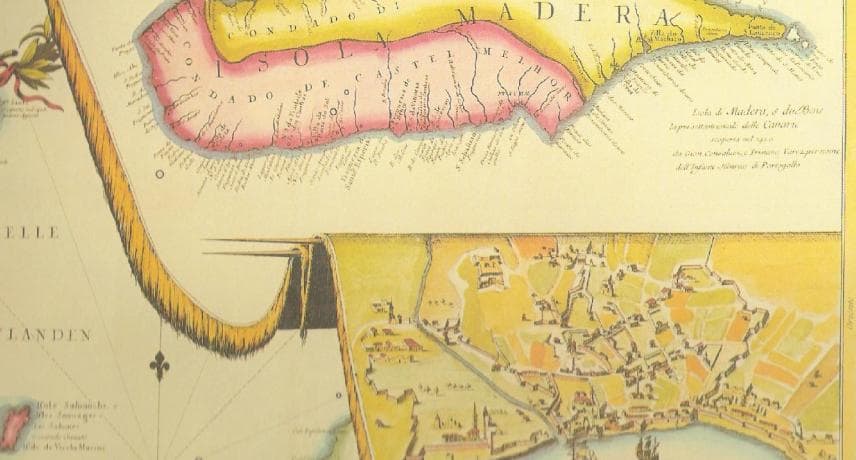
The origins of Madeira Island History date back to the Miocene period, about 5 million years ago when volcanic explosions occurred in the western part of the Atlantic Ocean. Successive eruptions deposited lava layers, ash and rocks that eventually emerge forming a series of islands: Madeira Island, the largest and most populated; tens of kilometres north-east the Porto Santo Island, the other inhabited island to east, small and uninhabited Desertas islands; and 250 km south of Funchal the Selvagens islands, now classified as nature reserves.
The archipelago was uninhabited until 1419, when the Portuguese navigator João Gonçalves Zarco landed in Madeira. However, Greeks, Romans, Phoenicians and Arabs surely would pass by Madeira, during his expeditions across the North Atlantic.
The arrival, in 1419, the first Portuguese ships have been fortuitous. Navigators in the service of Prince Henry the Navigator find Porto Santo Island, when exploring the coast of Guinea, were dragged to west by a violent storm. The island would therefore be baptised as Porto Santo “Saint Port”. With the approval of the Prince, the fleet returned a year later to study another way to understand what was seen in distance, a shape that somehow appeared like a dark moster. It was Madeira Island!
Closely sight, the new lands must have appeared to his discoverers like an enchanted vision, a green paradise floating in the middle of the Atlantic. It was immediately baptised as Madeira “Wood” because of the abundant vegetation covering it. The giant tree trunks in Madeira influenced the Portuguese shipbuilding, allowing Quotas caravels of higher masts and raise castles of the bow and the stern, which contributed to the success of travel such as Vasco da Gama to India (1498) .
In order to ensure colonization, Henry the Navigator administratively divided the archipelago into three captaincies: Tristão Vaz, a noble warrior descent received the eastern part of Madeira, whose main town will become Machico; João Gonçalves Zarco, who had led the first expedition and fought the infant in Tangiers, was responsible for the remaining part, settling in Funchal; the settlement and governance of Porto Santo Island was responsible Bartolomeu Perestrelo, an Italian to serve the Portuguese crown. This division into captaincies remained until the Spanish occupation in 1580, then going across the territory to be administered by a governor. This situation would prevail thereafter, even after Portugal’s independence restoration in 1640.
The vine plantations and sugar cane were the basis of production in the archipelago and quickly dominated the island’s economy.
With the flourish of colonization, King Manuel I was interested in Funchal urbanization, and had built some of the most important buildings of that time, including the Sé Cathedral.
In the sixteenth century the Azores and Brazil surpassed Madeira as sugar cane exporters and the island began to receive less attention from the crown. It took successive attacks by pirates so that the monarchs return to pay attention to Madeira. The inhabitants lived in a state of permanent alert, always waiting for attacks from the sea. They had the habit to take refuge in the highest points of the island.
From this time, Portugal began to invest in the fortification of Funchal and Porto Santo is replaced by senior officers to reside permanently in the islands.
Madeira Wine flourished during the seventeenth century, dethroning sugar as the mainstay of the local economy. It was at that stage that the presence of the English on the island increased.
Throughout the eighteenth century the most important trade routes continued to go through Madeira. English fleet, both commercial and war, here they docked the way to the West Indies. And the same happened with the travel of scientists and explorers. Captain Cook and Charles Darwin spent here. In 1815 Napoleon passed in Madeira on the way to exile. The ship docked in Funchal bay to collect supplies and Madeira wine.
In the nineteenth century Russia became the main market of Madeira wine. Also in the history of North America no other wine had much prestige as the “Madeira Wine”, which for nearly 200 years dominated the halls, banquets and receptions.
During the nineteenth and twentieth centuries, Madeira became one of the first tourist destinations in Europe, mostly visited by European aristocracy of the time. The good air of the island and its landscapes were recommended by doctors to patients undermined by tuberculosis. Many came here to convalesce, as the writer Julio Dinis.
In 1910 Portugal became a republic, and in 1926 a dictatorship that would be led by Salazar for 36 years. During this period Madeira became militarily occupied, following a revolt in 1931.
The Portuguese revolution of 1974 brought a new era to the archipelago. Madeira ascended the political status of autonomous region.
Over the years the Madeira could again retrain, from a deprived region dependent on agriculture, one of the most attractive tourist destinations in Europe. Tourism has become the engine of the island’s economy, with emphasis on the quality of hotels, eco-tourism and natural landscapes.

